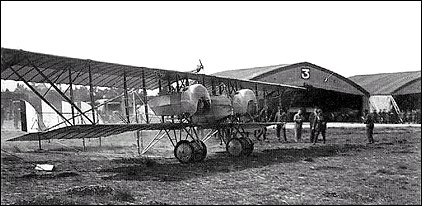 |
Caudron G.41915 |  |
| BOMBER, RECONNAISSANCE AIRCRAFT | Virtual Aircraft Museum / France / Caudron |
 |
The impossibility of installing effective defensive armament in the G.3 and its inability to lift a worthwhile bomb load led to the development of the twin-engined Caudron G.4 (or G.IV), which first appeared in March 1915. Structurally similar to its immediate predecessor, the G.4 had increased wing span, a tail-plane with four rudders instead of two, and twin engines mounted on struts between the wings. Power was provided by either 60kW Le Rhone rotary engines with 'horse-shoe' or circular cowlings, or by uncowled 75kW Anzani radials. The short crew nacelle had an observer/gunner's cockpit in the nose, though the field of fire was limited by the proximity of the engines. Locating the engines near the crew nacelle did, however, render the G.4 relatively easy to control in the event of an engine failure. A good rate of climb, increased useful load and outstanding reliability promised increased operational capability compared with types currently in Allied service, and the G.4 was accordingly ordered into large-scale production. Two versions were built, the Cau 4 B.2 day bomber and the Cau 4 A.2 artillery observation and reconnaissance aircraft. Entering service with the French Aviation Militaire in November 1915, the G.4 was the first Allied twin-engined type to equip first-line units in any quantity. It played a leading role in bombing raids launched on targets behind the German lines as far distant as the Rhine-land. However, increasing losses during the summer of 1916 led to withdrawal of French G.4 B.2s from first-line bomber units that autumn. Production of the G.4 in France totalled 1,358. The British Royal Naval Air Service purchased 55 of the type, 43 imported and 12 built by the British Caudron Company. Flown by Nos 4 and 5 Wings, they were used in 1916 and early 1917 in attacks on German seaplane and airship bases in Belgium. One of the most important raids was made by No. 7 Sqn, RNAS, on the Bruges area in February 1917, but the RNAS G.4s were replaced by Handley-Page O/100s in the autumn of 1917. The Italian Aeronautica Militare received imported G.4s and was also supplied with 51 examples built by the A.E.R. company at its factory near Turin. In May 1917 the 48a Squadriglia was the first unit to re-equip with the G.4, to be followed by the 49a and 50a Squadriglie. Italian G.4s operated in the mountainous Alpine areas, demonstrating their good climb qualities and suitability for flying at altitude, often in poorweather conditions. During the war the type established several Italian altitude records. Numbers of Caudron G.4s were also supplied to the Imperial Russian Air Service, with which they flew in the reconnaissance role. As well as a 7.7mm Lewis or Vickers machine-gun on a ring mounting in the front cockpit, some G.4s had a second Lewis gun mounted over the upper wing centre section for rear defence. Unfortunately, however, this second gun could only be operated with difficulty by the gunner standing at full stretch in his cockpit. An offensive load of 100kg of bombs could be carried by the G.4 B.2 bomber version. A number of the G.4 A.2 version had wireless installed for reconnaissance or artillery spotting. Towards the end of World War I G.4s were relegated to training duties, and 10 of the type were bought for that purpose by the United States Air Service in France in early 1918. The G.4 gained a reputation for good flight characteristics, winning praise from such distinguished wartime pilots as the Italian ace Silvio Scaroni and the French ace of aces Rene Fonck. As a result it was used for a number of notable post-war flights and some hundreds were sold to private owners and flying clubs in France and Italy.
|  All the World's Rotorcraft | |||||||||||||||||||||||||||||||||||||||||||||||||||
 |

|
